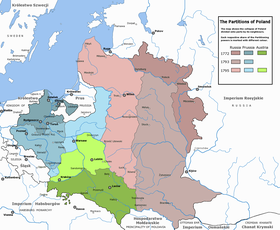Russian Partition
| The Russian Partition | |
|---|---|
| The Commonwealth | |

The Polish–Lithuanian Commonwealth in 1772
|
|
| Elimination | |

The three partitions of the Polish–Lithuanian Commonwealth. The Russian Partition (Red), the Austrian Partition (green), and the Prussian Partition (blue)
|
The Russian Partition (sometimes called Russian Poland) constituted the former territories of the Polish–Lithuanian Commonwealth that were invaded by the Russian Empire in the course of late-18th-century Partitions of Poland. The Russian acquisition encompassed the largest share of Poland's population, living on 463,200 km2 (178,800 sq mi) of land constituting formerly east-central territory of a sovereign country. The first partitioning led by imperial Russia took place in 1772; the next one in 1793, and the final one in 1795, resulting in Poland's elimination for the next 123 years.
To both Russians and Poles, the term Russian Poland was not acceptable. To the Russians after partition Poland ceased to exist, and their newly acquired territories were considered the long lost parts of Mother Russia. To Poles, Poland was simply Polish, never Russian. While the Russians used varying administrative names for their new territories (see below), another popular term, used in Poland and adopted by most other historiographies, was the Russian Partition.
Even before the partitions from the late 18th century, the Russian Empire had already acquired some territories of the Polish-Lithuanian Commonwealth (a real union of Kingdom of Poland with the Grand Duchy of Lithuania). The first Russian partition took place in the late 17th century, when the forced Treaty of Andrusovo signed in 1667 granted Russia the Commonwealth's territory in the Western Ukraine. Under the Third Partition of Poland Russia acquired Courland, all Lithuanian territory east of the Nieman River, and the remaining parts of Volhynian Ukraine.
...
Wikipedia
